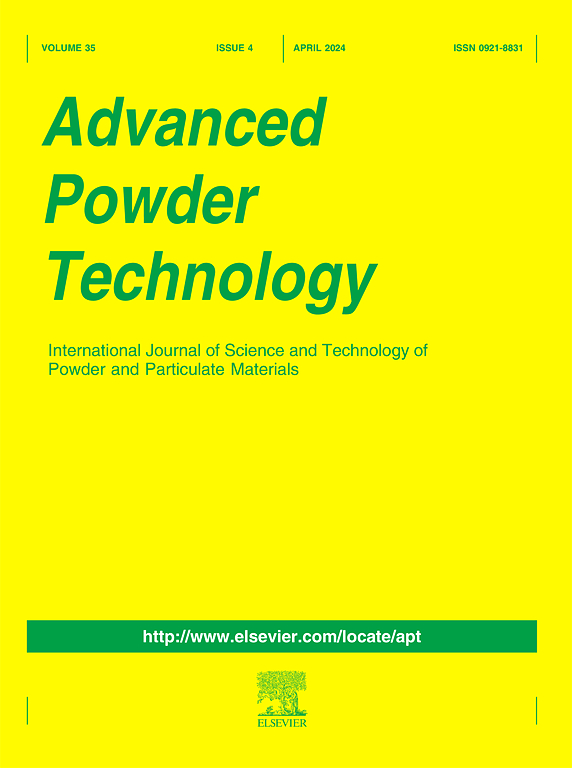Depression mechanism of a novel environment-friendly depressant konjac gum in flotation separation of chalcopyrite and sphalerite
IF 4.2
2区 工程技术
Q2 ENGINEERING, CHEMICAL
引用次数: 0
Abstract
Conventional inorganic depressants are widely used in the flotation separation of chalcopyrite and sphalerite. However, their widespread use entails some inevitable disadvantages, such as environmental hazards, waste generation, and additional costs. In this work, Konjac gum (KG) was investigated as a non-toxic and eco-friendly sphalerite depressant in the flotation separation of chalcopyrite and sphalerite. Micro-flotation and artificial mixed mineral experiments suggested that the addition of KG dramatically depressed the floatability of sphalerite while having a negligible depressive effect on chalcopyrite at pH = 7. Wettability measurements, Zeta potential measurements, adsorption measurements and interaction energy calculations showed that KG have a stronger affinity to sphalerite rather than chalcopyrite, preventing the adsorption of collector on sphalerite surface. FTIR and XPS measurements demonstrated that KG could interact with sphalerite and change the chemical environment of oxygen atoms on sphalerite surface. The Bronsted acid-base interaction, hydrogen bonding, and the attraction between the hydrophobic sections of KG and sphalerite surface were considered as the potential mechanisms in the adsorption of KG on sphalerite.

新型环保型抑制剂魔芋胶在黄铜矿和闪锌矿浮选分离中的抑制机理研究
常规无机抑制剂广泛应用于黄铜矿和闪锌矿的浮选分离。然而,它们的广泛使用带来了一些不可避免的缺点,例如环境危害、产生废物和额外费用。研究了魔芋胶作为一种无毒环保的闪锌矿抑制剂在黄铜矿和闪锌矿浮选分离中的应用。微浮选和人工混合矿物实验表明,在pH = 7时,KG的加入显著抑制闪锌矿的可浮性,而对黄铜矿的抑制作用可以忽略不计。润湿性测定、Zeta电位测定、吸附量测定和相互作用能计算表明,KG对闪锌矿的亲和力大于对黄铜矿的亲和力,阻止了捕收剂在闪锌矿表面的吸附。FTIR和XPS测试表明,KG与闪锌矿发生相互作用,改变闪锌矿表面氧原子的化学环境。研究认为,KG在闪锌矿表面的吸附机理包括:Bronsted酸碱相互作用、氢键和疏水部分与闪锌矿表面的相互吸引。
本文章由计算机程序翻译,如有差异,请以英文原文为准。
求助全文
约1分钟内获得全文
求助全文
来源期刊

Advanced Powder Technology
工程技术-工程:化工
CiteScore
9.50
自引率
7.70%
发文量
424
审稿时长
55 days
期刊介绍:
The aim of Advanced Powder Technology is to meet the demand for an international journal that integrates all aspects of science and technology research on powder and particulate materials. The journal fulfills this purpose by publishing original research papers, rapid communications, reviews, and translated articles by prominent researchers worldwide.
The editorial work of Advanced Powder Technology, which was founded as the International Journal of the Society of Powder Technology, Japan, is now shared by distinguished board members, who operate in a unique framework designed to respond to the increasing global demand for articles on not only powder and particles, but also on various materials produced from them.
Advanced Powder Technology covers various areas, but a discussion of powder and particles is required in articles. Topics include: Production of powder and particulate materials in gases and liquids(nanoparticles, fine ceramics, pharmaceuticals, novel functional materials, etc.); Aerosol and colloidal processing; Powder and particle characterization; Dynamics and phenomena; Calculation and simulation (CFD, DEM, Monte Carlo method, population balance, etc.); Measurement and control of powder processes; Particle modification; Comminution; Powder handling and operations (storage, transport, granulation, separation, fluidization, etc.)
 求助内容:
求助内容: 应助结果提醒方式:
应助结果提醒方式:


